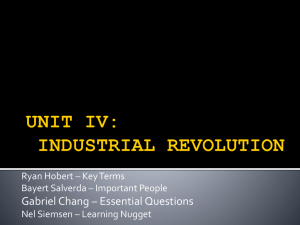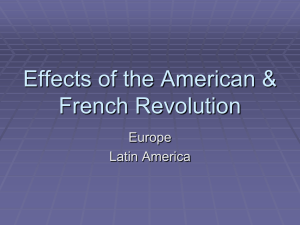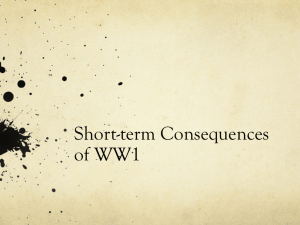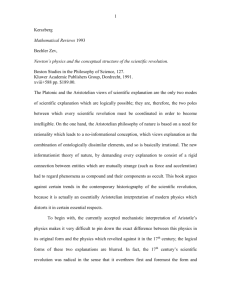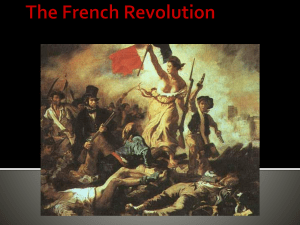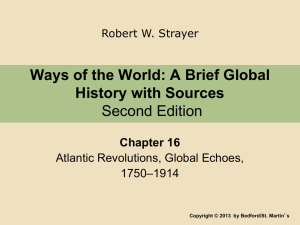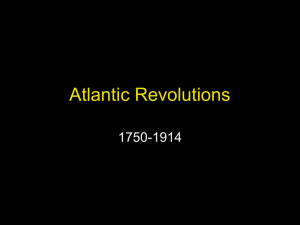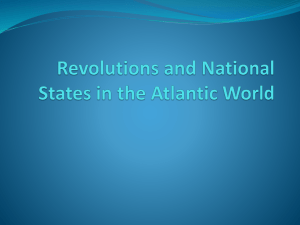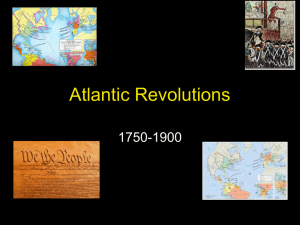History of Science
advertisement
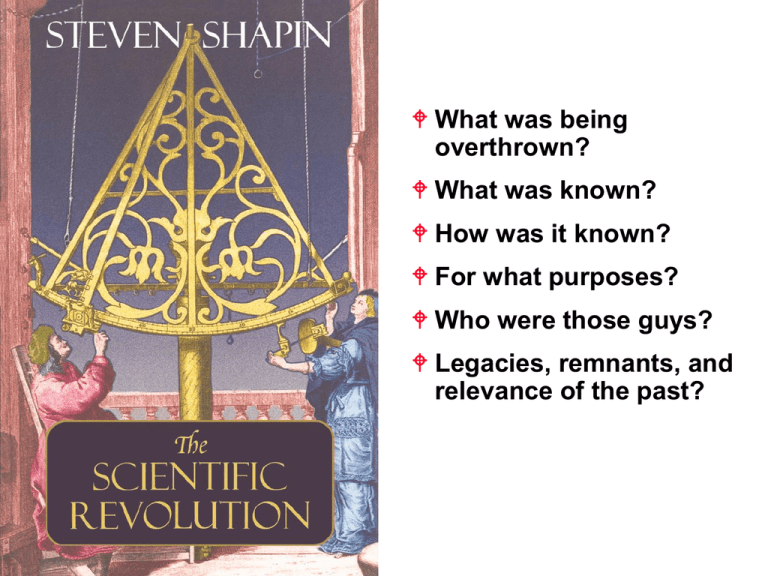
What was being overthrown? What was known? How was it known? For what purposes? Who were those guys? Legacies, remnants, and relevance of the past? Scientific Revolution(s) The Scientific Revolution is a term commonly referring to the transformation of thought about nature through which the Aristotelian tradition was replaced by so-called "modern" science. Most see it as a series of events focused in the period 16th and 17th century or, more precisely, from 1543 (De Revolutionibus of Copernicus) to 1687 (Principia of Newton). Others grant it some status from 1300 to 1800. Still others, see revolutions all around, Glorious, American, French, Industrial, Chemical, Darwininan, Freudian, Russian, Quantum, and Plate Tectonics. Revolution, revolutions, or evolution of ideas, it depends on who you read. History of Science… Studies the change of natural knowledge claims over time and also the causes of these changes. A vast field (Plato-NATO) embracing many different scientific traditions, from Algebra to Zoology. “Today’s science is tomorrow’s history of science.” “Science dynamics.” Program in Science, Technology, and Society 5881 Mayflower Hill, Waterville, ME 04901 Phone 207-859-5881 Dr. Myron Gutmann, Director SBE Directorate National Science Foundation 4201 Wilson Blvd Arlington, VA 22230 mgutmann@nsf.gov Nov. 18, 2010 Dear Dr. Gutmann, I don’t know the practical budgetary pressures you are facing, but I do wish to make the case for understanding science and science policy by studying its history. We are all 21st century citizens and our social trajectory is aimed squarely at the future, yet our knowledge is shaped by what we have and have not done in the past. Historians study change over time and the underlying causes of these changes. They identify events, trends, and common shared experiences that place people and their environment in larger contexts. History matters. It shapes collective identities and consciousness on all temporal and spatial scales from personal to national to global. Framed properly, history is an essential and accessible component of informed decision-making and interdisciplinary communication, and serves as a resource for future innovation and citizen involvement. I study Climate, Climate Change, and Climate Dynamics by examining “Science Dynamics,” the complex web of intellectual, social and technical influences surrounding science. My recent work on the history of weather and climate control is serving to inform decision makers in Washington, including the US House Committee on Science and Technology, chaired by Bart Gordon, where I testified last year; the Governmental Accountability Office (GAO), which uses my work in its study of geoengineering; and the National Academy of Sciences Government, University, Industry Research Roundtable (GUIRR) in which I participated as a historian just last month. My historical work on Earth observations from space is documented in a 2007 NRC report. Many of my colleagues do similar work at the cutting edge of public policy. If we don’t study the past, then every decision we face will seem unprecedented. If we don’t study the history of science and apply its lessons, then I don’t think we can say we really understand science. I hope you will act to maintain a robust STS Program within NSF. Sincerely, James R. Fleming Professor and Program Director of Science, Technology, and Society Aristotelian natural philosophy Aristotelian Cosmology Sublunar realm: Natural place and natural motion Generation and corruption Four elements: earth, water, air, and fire Cold, hot, most, dry, affinity and opposition Heavens: Uniform circular motion Perfect and incorruptable Quintessence or aether The sub-lunar realm Hippocrates, Airs, Waters, Places Emphasized the effects of climate and other geographical factors on human health. Climate is a primary influence, but human institutions could have a moderating effect. Overall, however, the relationship between health and lifestyle is under the direct influence, if not the control, of airs, waters, and places. Hippocratic medicine Scientific Revolutions Nicholas Copernicus (1473 – 1543) Andreas Vesalius (1514-1564) De humani corporis fabrica…, 1543 On the fabric of the human body William Harvey (1578 –1657) and the circulation of the blood De Motu Cordis 1628 Francis Bacon (1561-1626) Natural Philosopher Government Official Lord Chancellor Novum Organon Great Instauration New Atlantis Compass, Gunpowder, Printing The ant, the spider, the bee William Gilbert De Magnete (1600) Galileo Galilei (1564-1642) Kinematics and Astronomy Telescope Sunspots, Phases of Venus, Lunar craters, Moons of Jupiter, Milky way made of stars Support of Heliocentrism Experiments with falling bodies Mathematics of motion Galileo explains his discovery to the Pope René Descartes (1596-1650) Mathematics and Natural Philosophy Analytic geometry Le monde (1633) L’Homme (1637) Discours de la Méthode (1637) Principia philosophia (1644) Les Passions de l’âme (1649) Dynamics Evangelista Torricelli’s Experiment (1644) Nature does not “abhor a vacuum” and the air has weight. Blaise Pascal and Florin Périer On September 19, 1648, Florin Périer and some friends perform the Torricelli experiment on top of Puy de Dôme in central France. The height of the mercury column is 85 mm less than in Clermont-Ferrand at the base of the mountain, about 1000 meters below. Robert Boyle (1627-1691) Experimental Method, Natural Philosophy Air Pump Skeptical Chymist (1661) Boyle’s Law Royal Society of London Public Verification of Science An experiment on a bird in the air pump, by Joseph Wright Isaac Newton (1642-1727) Theory of Light Theory of Motion Theory of Gravity Philosophiae Naturalis Principia Mathematica (1667) Dynamics Alchemy Theology Master of the Mint Newtonian World System Mechanical Philosophy Natural law Reductionistic Mathematical Materialistic Anti-teleological Inductive Observation Experimental method Clockwork universe Herbert Butterfield (1949) Since the Scientific Revolution overturned the authority in science not only of the middle ages but of the ancient world Since it ended not only in the eclipse of scholastic philosophy but in the destruction of Aristotelian physics It outshines everything since the rise of Christianity and reduces the Renaissance and Reformation to the realm of mere episodes, mere internal displacements, within the system of medieval Christendom. Historian Alexandre Koyre had first used the term Scientific Revolution in 1943 when he called it, “the most profound revolution achieved or suffered by the human mind.” Carolyn Merchant, The Death of Nature. The removal of animistic, organic assumptions about the cosmos constituted the death of nature—the most farreaching effect of the Scientific Revolution. Because nature was now viewed as a system of dead, inert particles moved by external, rather than inherent forces, the mechanical framework itself could legitimate the manipulation of nature. Moreover, as a conceptual framework, the mechanical order had associated with it a framework of values based on (masculine) power, fully compatible with the directions taken by commercial capitalism. Thomas Kuhn, The Structure of Scientific Revolutions What are scientific revolutions all about? 1. The community's rejection of a time-honored scientific theory in favor of another incompatible (or incommensurable) with it. 2. A shift in the problems available for scientific scrutiny and the standards of legitimate problem solving. 3. Each involved a transformation of the scientific imagination and worldview. 4. Each involved heated controversy. 5. Each was followed by a period of “normal science” 6. Examples: Copernicus, Newton, Lavosier, Einstein. Is there a “Post-normal” science? 'Post-Normal Science', a mode of scientific problem-solving appropriate to policy issues where facts are uncertain, values are in dispute, stakes are high and decisions are urgent. Today’s blogs are becoming the equivalent of printing which empowered the Protestant revolution against the Church. Scientific elites vs. the extended “peer-to-peer” community with its new technological base,” the internet. Wikipedia, post-normal science Opens more of science to the democratic process. Problems: Critics are not usually researchers. Junk science. Conspiracy theorists. Needed: ethics in science, open data, and reform of peer review.



